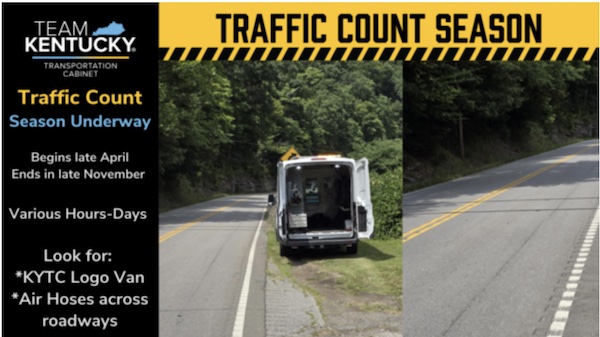We’re Out for the Count
Traffic Count Season Underway at KYTC District 12
PIKEVILLE, Ky. – (July 17, 2024)The Kentucky Transportation Cabinet (KYTC) District 12 announces that traffic count season is underway, and wants to remind residents that crews will be working alongside roads across the region to deploy counting equipment.
Traffic counts are important tools to monitor and analyze traffic patterns on state and local highways, providing valuable data for future road improvements and planning studies.
How Traffic Counts Work
To conduct a traffic count, rubber air hoses laid across the road is the predominate method used in Kentucky. When vehicles drive over the hoses, the air pressure difference generated helps record traffic numbers. The system can differentiate between various types of vehicles, including cars, heavy trucks, and motorcycles without causing any damage to the vehicles. The hoses are designed to be durable and safe for all types of traffic.
Types of traffic counts include a volume count that uses one hose to measure the total traffic in a particular area and a class count that uses two hoses to provides data on the types and total number of vehicles, distinguishing between cars, trucks, motorcycles, and more.
Why We Conduct Traffic Counts
Traffic counts are conducted at locations every few years, as staff and scheduling allow, to monitor traffic trends over time. This information is critical for planning studies to understand traffic trends and the nature of traffic flow for future improvements.
The data is made available to engineers, local governments, area development districts and others involved in transportation design or infrastructure planning, as well as the public.
Count schedules are often prioritized for areas where roadway changes are being designed; and, to ensure data is accurate, counts are often deferred if paving or construction could interrupt or affect area traffic flow.
What to Expect on Roads
In District 12 counties, motorists may notice a white traffic van with the KYTC logo, usually parked near a sign or guardrail where the counter box is secured, and one or two long hoses stretched across the road. In rare instances, counter boxes may be secured to fence posts, mailboxes or other fixtures on the right of way if no other options are available at the location. It is crucial that these counter boxes remain undisturbed to ensure accurate data collection.
Hoses attached to the counter boxes are typically set out and left in place anywhere from two to seven days to capture a baseline of regular driving patterns. While most count work occurs during regular business hours, counts in high-volume areas may be set up during the night and early morning hours on some occasions.
Traffic count season runs from early April to late November. During this time, motorists are advised to be mindful of state highway crews setting up traffic counts, slow down, and drive carefully.
To find counts in your local area, please visit the KYTC Planning division’s traffic counts page online at https://transportation.ky.gov/Planning/Pages/Traffic-Counts.aspx.













![Foothills-Bundle] Foothills-Bundle](https://thelevisalazer.com/wp-content/uploads/2020/05/Foothills-Bundle-422x74.jpg)






